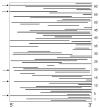Characterization of salivary RNA by cDNA library analysis
- PMID: 17052683
- PMCID: PMC2743855
- DOI: 10.1016/j.archoralbio.2006.08.014
Characterization of salivary RNA by cDNA library analysis
Abstract
Oral fluid (saliva) meets the demands for a noninvasive and accessible diagnostic medium. Recent reports by our group and others described the presence and use of human RNA in saliva as a diagnostic or forensic tool, including the use for oral cancer detection. To gain insights into the integrity of salivary RNA, we examined in detail the integrity of salivary RNA by generating a cDNA library from pooled supernatant saliva of 10 healthy donors. From a library with a primary library titer of 1.3 x 10(6) cfu/mL of which 95% of the clones had inserts, we successfully sequenced 117 random colonies containing recombinant clones. BLAST search results indicated that all of these clones contained sequences of human origin. Most of the salivary RNAs appeared to be endonucleolytically cleaved at random positions as indicated by comparisons to respective full length parental RNAs from the Genbank. Twelve of the insert sequences matched to the normal salivary core transcriptome sequences, which are highly abundant mRNAs present in healthy individuals. This study provides an in-depth molecular analysis of the saliva transcriptome and should be a useful resource for future basic and translational studies of RNA in human saliva. In addition, this paper presents unequivocal evidence for the presence of RNA in saliva as determined by the use of diverse techniques such as reverse transcriptase quantitative polymerase chain reaction (RT-qPCR), in vitro translation, and the construction of a salivary cDNA library.
Figures




References
-
- Li Y, Zhou X, St John MA, Wong DT. RNA profiling of cell-free saliva using microarray technology. J Dent Res. 2004;83(3):199–203. - PubMed
-
- Juusola J, Ballantyne J. Messenger RNA profiling: a prototype method to supplant conventional methods for body fluid identification. Forensic Sci Int. 2003;135(2):85–96. - PubMed
-
- Nussbaumer C, Gharehbaghi-Schnell E, Korschineck I. Messenger RNA profiling: a novel method for body fluid identification by Real-Time PCR. Forensic Sci Int. 2006;157(23):181–6. - PubMed
-
- Gomes MA, Rodrigues FH, Afonso-Cardoso SR, Buso AM, Silva AG, Favoreto S, Jr, et al. Levels of immunoglobulin A1 and messenger RNA for interferon gamma and tumor necrosis factor alpha in total saliva from patients with diabetes mellitus type 2 with chronic periodontal disease. J Periodontal Res. 2006;41(3):177–83. - PubMed
-
- Li Y, St John MA, Zhou X, Kim Y, Sinha U, Jordan RC, et al. Salivary transcriptome diagnostics for oral cancer detection. Clin Cancer Res. 2004;10(24):8442–50. - PubMed
Publication types
MeSH terms
Substances
Grants and funding
LinkOut - more resources
Full Text Sources
Other Literature Sources
Research Materials

